Museums & Institutions
As 26 Looted Treasures Go on View in Benin Republic, the West African Cultural Community Is Asking: What Happens Next?
Scholars, artists, and politicians believe that restitution is about more than just the objects.
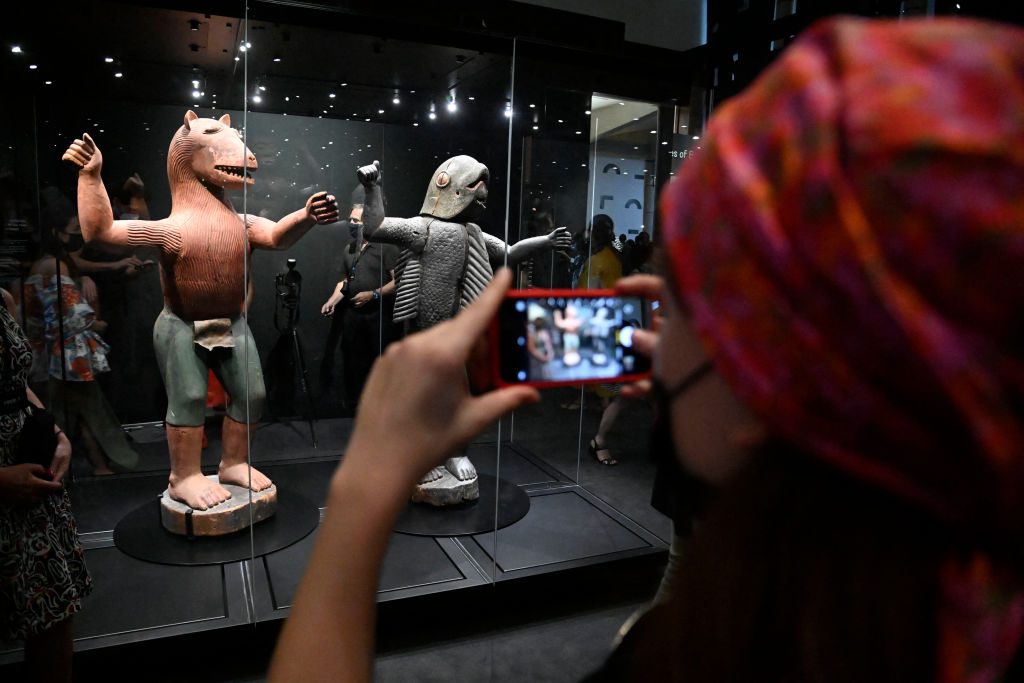
Scholars, artists, and politicians believe that restitution is about more than just the objects.

Tobi Onabolu

“Since Senghor, we haven’t had an African president invest so much in art as now,” gallerist Adenile Borna Soglo told Artnet News, referencing the poet, politician and cultural theorist who served as the first president of Senegal. An air of national pride—with perhaps a sprinkling of hyperbole—has been percolating through Cotonou.
Twenty-six royal objects are currently on display in the former presidential palace in Benin’s administrative capital, returned from the Quai Branly Museum in France last November. In 1892, after two years of war with the Danhomeans, French troops looted the Abomey palaces and city, seizing the royal objects, which were donated to the Trocadero Museum of Ethnography. From 2000, the objects were kept at the Quai Branly.
The objects include an anthropo-zoomorphic statue depicting King Behanzin, by artist Sossa Dede, as well as several ceremonial thrones, and a soldier’s tunic. The public showcase forms part of an ongoing exhibition, “The Art of Benin of Yesterday and Today, from Restitution to Revelation: Royal Treasures and the Contemporary Art of Benin,” which runs until May.
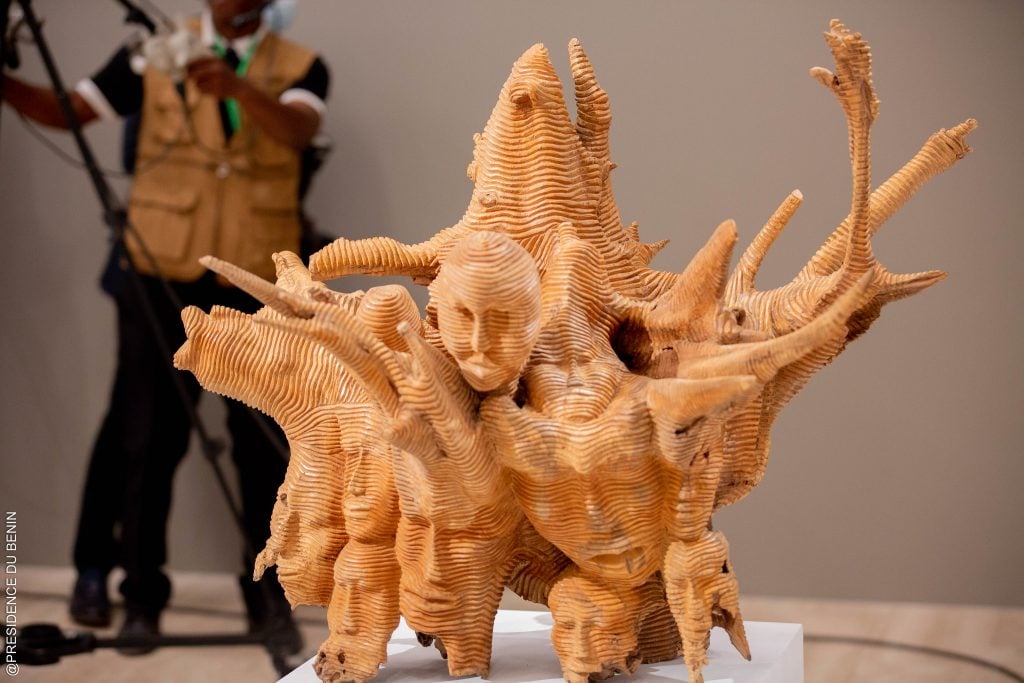
Épaphras Dègnon Toïhen, Les Vivants (2021). ©Presidence du Benin.
Free to the public, and reportedly fully booked until closing, the exhibition has been widely publicized in regional languages across the breadth of the country. And the response from guests has been overwhelmingly positive.
“It’s important to be able to discover the Beninse cultural identity,” one visitor to the exhibition, Hervé, said. The sentiment was echoed by another, Steeve Tsagli, who visited after hearing about the show on social media: “I’m incredibly proud to be here,” he said. Praise, a student from Lagos, added that it was “amazing” that the Benin government went to France to get these pieces back: “It’s their history.”
At a private preview, an address by Benin’s president Patrice Talon followed a reception held for the incumbent kings from Benin’s various royal families, including Dahomey. At the invitation of the presidency, other invited guests included Beninese artists, art historians, curators, and practitioners, as well as a delegation led by the French culture minister, accompanied by an extensive cohort from the French art scene.
“The Beninese are obsessed with history and legacy,” Olivia Anani, a Paris-based Beninese art dealer, said. “I came in just for the weekend to feel the energy of this historic moment.”
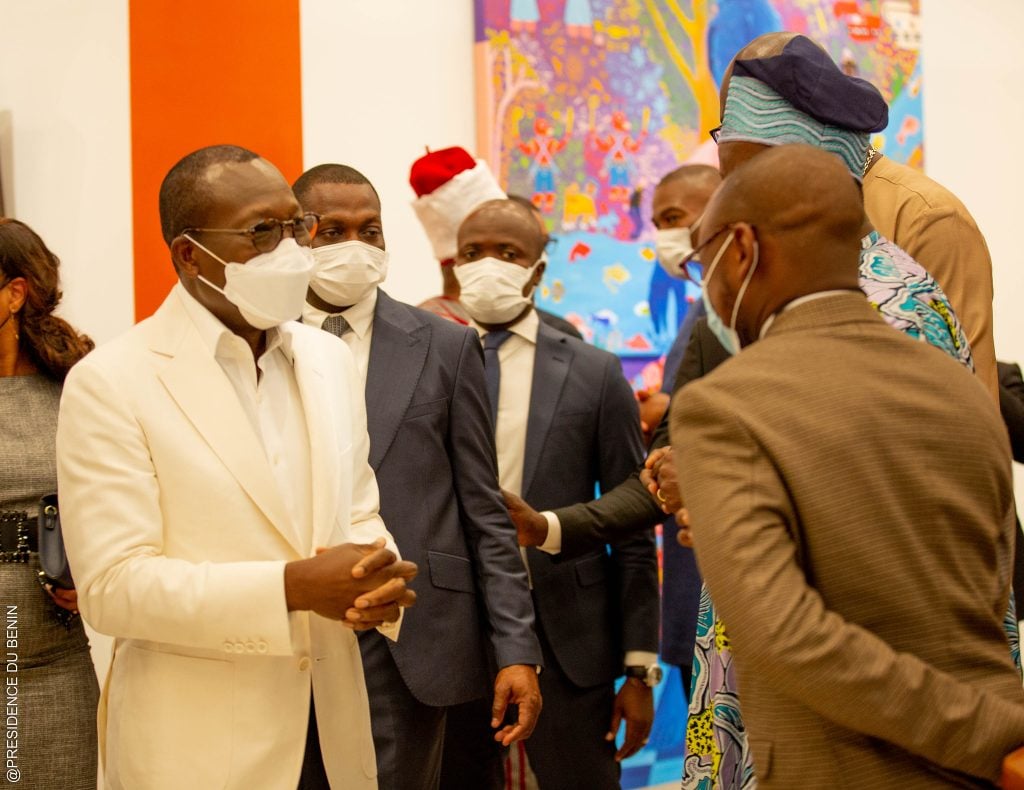
President of Benin Republic, Patrice Talon, engaging with guests at a private viewing. ©Presidence du Benin.
While onlookers were enthused about viewing these objects in their ancestral home, the conversation surrounding restitution extends past geography. “We have to talk about the re-contextualisation of these objects,” Ivory Coast-based artist and curator, Bayo Hassan-Bello insisted to Artnet News. “They had functional uses in society and possessed greater ontological and ancestral power, whereas in new contexts they serve new purposes.”
Man Ray’s Noir et Blanche photograph of French model Kiki de Montparnasse is a well-known example of such decontextualization. Art historians have interrogated themes such as commodification and fetishization, amid Euro-African power dynamics and a fresh wave of “negrophilia” in France in the 1920s. Therefore, despite the euphoria that the returned objects bring to Benin, many are keen to question the contexts in which these pieces are presented.
“These objects no longer serve the purpose of 100 and 200 years ago. Yet presenting [them] in glass cubes continues to decontextualize them,” Hassan-Bello said, adding that their purposes were beyond material. “Ethereal things don’t function in spaces of bureaucracy. Restitution is not just about the objects. It’s about so much more.”
Indeed, pan-Africanist scholar Achille Mbembe has frequently alluded to the “more,” notably in a 2019 interview, where he argued that the risk of restituting African heritage objects without offering a proper account of them removes their right to remind us of the truth. “I have been trying to relate the call for restitution to broader questions of debt, reparation and universal justice,” he said. “The truth is that Europe took things from us that it will never be able to restitute.”
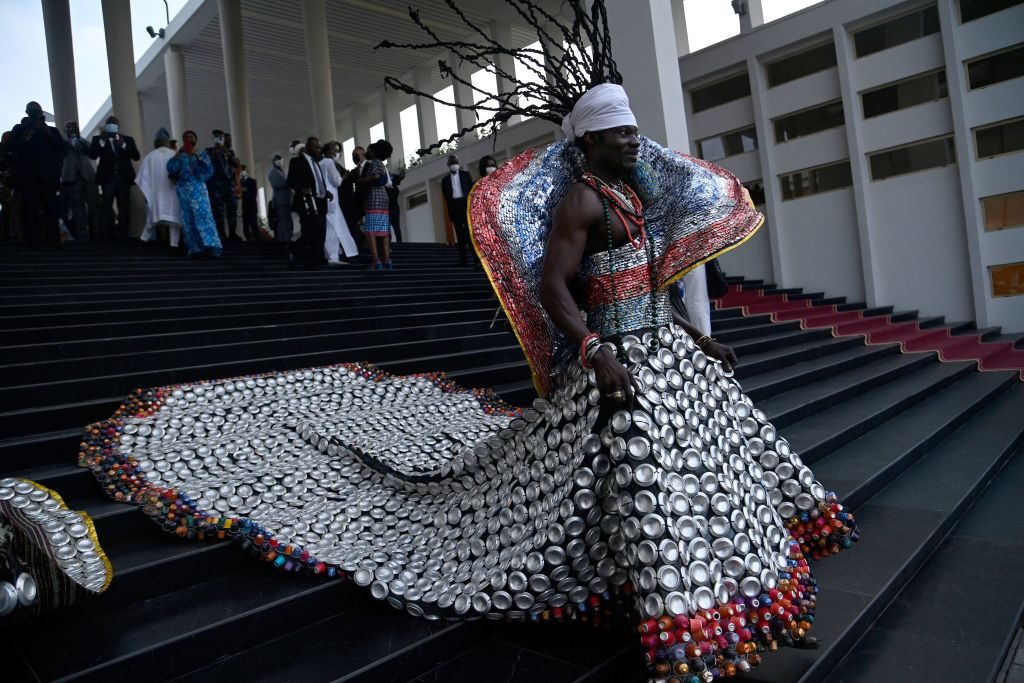
Prince Toffa’s performance piece during the opening preview. Photo by Pius Utomi Ekpei/AFP via Getty Images.
Another focus of the ongoing exhibition is to highlight Benin’s continued artistic prowess by shining a light on its contemporary art sector. A majestic performance piece by Prince Toffa, rooted in his up-cycling based practice, presented during the private preview, stilled onlooking guests. Additionally, 34 artists from Benin and its diaspora are on view in a dedicated section of the exhibit. Established artists including Ludovic Fadairo, Georges Adeagbo, Romauld Hazoume, and Julien SInzogan, are shown alongside younger artists Moufouli Bello, King Houdekpinkou, and Thierry Oussou.
“Culture is undoubtedly an important pillar of economic development,” Benin’s minister of culture Jean-Michel Abimbola told Artnet News, adding that the country plans to build four new museums by 2025. “The government is convinced that we can create an economy built on culture and tourism.”
Beninese national pride emerges as a clear victor from this moment, as does the French president Emmanuel Macron in the context of the soft power of his “FrancAfrique” relations as he campaigns for re-election later this year. “In the context of neo-colonialism, culture does not exist independent of politics, and this is political goodwill,” Hassan-Bello said, as he referenced the situation in Mali, where the interim government recently expelled the French ambassador to Mali. Contemporary Malian artist Aboubakar Fofana is among those who have criticized what he views as French neo-colonial efforts to keep control over West African resources by delegitimizing the country’s interim government.
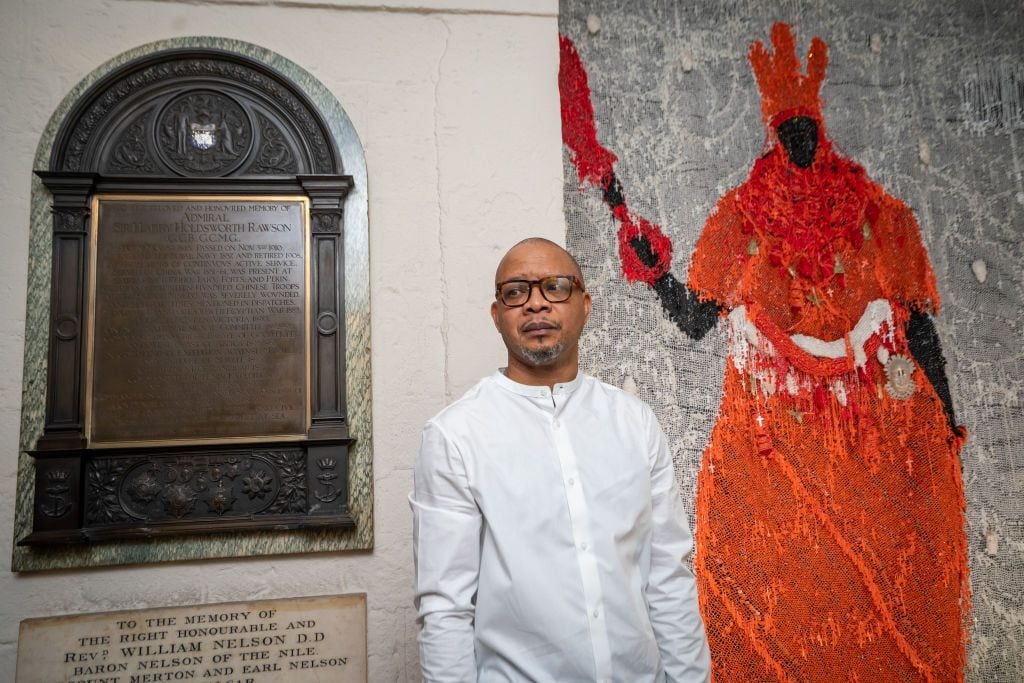
Artist Victor Ehikhamenor with his artwork Still Standing after its unveiling at St Paul’s Cathedral, in London, which will be on display in the crypt until 14 May 2022. Picture date: Thursday February 17, 2022. Photo by Aaron Chown/PA Images via Getty Images.
Meanwhile in Nigeria, plans are underway to build the Edo Museum of West African Art (EMOWAA), designed by Adjaye Associates, which will house ruins, artifacts, and un-investigated objects from the Edo Kingdom. While museums in the USA and Germany have made promises to return looted bronzes to the Benin City royal palace, the British Museum, which is a supporting partner of the project, has only ever alluded to the possibility of “loaning” back, rather than transferring ownership of, these mass looted items.
“It’s as if they think they have more superior thinking, facilities, and knowledge, but it is the same form of thinking that informed the removal of these objects in the first place,” said Peju Layiwola, a professor and artist who has been working closely with the incumbent Oba of Benin on the return of the looted bronzes, which are now housed across the world. He added the popularly held belief that Western museums are “hiding behind laws and clauses” to avoid responsibility for returning these works.
“An institution like the British Museum adopts a policy of “retain and explain”, and their use of language in captioning looted artifacts is a weapon in keeping these objects,” said artist Victor Ehikhamenor, whose work marking 125 years since the bronzes were looted is currently on display at St Paul’s Cathedral in London. He added that museums seem to cling unnecessarily tightly to this particular set of stolen objects. In the context of Benin City, for example, bronze casting practices had been in existence for centuries, and did not end with the arrest of Oba Ovonramwen in 1897. “What importance are we lending to those objects that were not stolen or produced a little later?” he asked.
With the Dakar Biennale set to return for the first time in four years, a cultural rebirth is well and truly bubbling across the breadth of west Africa. But while countries such as Nigeria and Ghana continue to lean on private industries to sustain their art sectors, in Benin, the state has taken control. And by taking the lead on restitution, Benin Republic is propelling itself into the heart of this narrative.